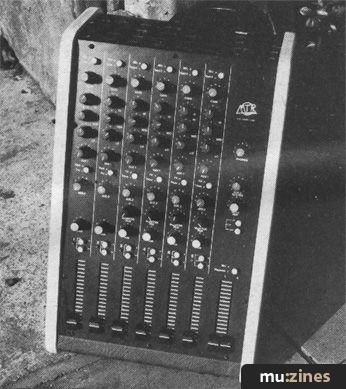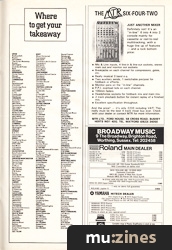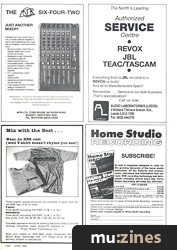Magazine Archive
Home -> Magazines -> Issues -> Articles in this issue -> View
MTR 6-4-2 Mixer | |
Article from Home & Studio Recording, June 1984 | |

When it comes to choosing a budget-priced mixer to work with many of the current 4-track reel-to-reel and cassette machines, there are surprisingly few suitable products in the under £500 price range.
At £226 all-in, MTR's 6-4-2 mixer seems an absolute bargain on price alone. Further investigation actually reveals an incredibly flexible unit that has been purpose-built for home recording, with a range of features that make one man operation simplicity itself.
Design
With a brown pressed metal casing, trimmed with chunky pinewood end cheeks, and conventional mixer pots, the MTR unit has a certain utilitarian feel to it. That's not a criticism, such cosmetic sacrifices are only to be expected if the mixer is to remain affordable to as many people as possible.
In terms of layout, the mixer follows convention having the six input channels side by side with the master section to the right. All input and output connections use jack sockets located on the slightly angled rear panel and aligned with their respective channels, for easy reference. The provision of six channels means that four can be used to control the four tracks of a tape recorder with two spare inputs. To this end, MTR have assigned channels 3-6 as the tape returns, and controls and connections have been included so that no re-plugging of leads is required during a recording session.
Connecting Up
On the rear panel, each channel has a jack input (50 kilohms) for high impedance microphones, but it's also suitable for line level inputs if the gain is reduced. Channels 1 and 2 have Line Input jacks (-30dB) which accept signals from most synths, guitars and drum machines, while the same sockets on channels 3-6 are designed to connect with the return tape signals from a 4-track recorder. There are also four Tape Line Out jacks on these channels which are designed to connect with the inputs of the same recorder.
The final channel connection is an Insert socket. This uses a stereo jack (tip = send, ring = return) to send the input channel signal out to an effects device and back into the same channel. This means a separate effect can be added to all six inputs (either during initial recording or mixdown) if connected to each of the insert sockets, which greatly increases the scope of the mixer.
A Stereo Output socket lets you connect a stereo (or mono) tape recorder/cassette to record your final 'master' mix, and the 2 Track In jack socket should be used for the return signals. With such connection made, a front panel Mix/Playback button allows you to hear the recorded end result without resort to repatching leads, simply by selecting Playback.
Monitor Output provides a stereo mix of the input/tape signals and is intended for connection to an amp and speakers. Alternatively, it can be used as an extra headphone socket if monitor speakers are not being used, and several people wish to hear the mix.
The MTR 6-4-2 is equipped with two auxiliaries: Aux 1 is intended as a foldback (prefade) cue which accounts for the fact that there's only an Aux Out socket on the rear. Aux 2, however, is a fixed post-fade control and is supplied with rear panel mono Send and Return sockets which complete the rear connections. These should be connected to an effect that you're likely to want on several channels simultaneously, such as reverb. The level coming from the effects device is controlled by the front panel Aux 2 Return knob and the Aux 2 Pan and routing buttons mean that the auxiliary effect can be sent to any of your four groups (ie. tape tracks) or positioned in stereo across the main Left/Right outputs.
Channel Format
Each of the input channels share the following controls: a mic/line input gain control, three band fixed frequency equalisation, two auxiliary send level controls (with a selector button - more of this later), a channel Pan control and routing buttons, a peak overload LED and finally a 105mm long travel fader which controls the output level to the tape track and stereo mix.
In addition, channels 1-2 feature a pre or post-fader selector button for auxiliary 1. This adds greater flexibility to these inputs as it permits Aux 1 to be used as another effects send (like Aux 2) if no foldback is required, such as during the final mixing stages of a multitrack tape.
The equalisation offers around 18dB of cut and boost to signals at 12kHz, 2kHz and 80Hz. When I confronted these frequencies on the spec sheet I thought I was in for a repeat performance of the inadequate EQ of the Yamaha RM804 mixer reviewed last month, whose chosen frequencies are virtually identical. Fortunately, MTR have resorted to very wide EQ bandwidths for each control instead of the very 'peaky' response of the Yamaha unit. In practical terms, the degree of equalisation is quite good, and is all that can truly be expected from a mixer of this price. Personally I would have lowered the Mid and Hi frequencies a touch.
Although lacking any type of visual metering of signal levels, the MTR does include a red peak programme indicator (PPI), which is electrically located after the EQ, on every input, and is of considerable help in setting optimum input levels - the record levels are best monitored via the multitrack recorder's own meters, which is how I did it and encountered no difficulties with a Teac A3440.
Channels 3-6 operate as four subgroups, if the mixer is used as anything more than a straight six channel stereo mixer, which are permanently connected to the multitrack recorder. If mic level signals are used on every channel, as when recording a drum kit say, they can be routed to any tape track, by selecting either group 1/2 or 3/4 pushbuttons and turning the Pan control fully left or right as required. With both pushbuttons in their 'out' position the input is sent directly to the main Left and Right outputs and to the monitor speakers.
To listen to recorded 'off-tape' signals whilst still recording via the same channel (3-6 only), the Auxiliary 1 pushbutton must be pressed down to its Tape Cue position. The recorded signals are then automatically routed to a Monitor Pan control (channels 3-6 only) which lets you position your recorded tracks in the monitor mix. Without this control, panning would be unavailable as the other channel pan is already being used to route the inputs to tape.
With the home recordist in mind once again, two headphone sockets are provided on the mixer's front edge. One provides a duplicate signal as from the main Monitor Out socket and is stereo, with level control coming from a Phones volume at the top right of the mixer. The second socket is fed by the Aux 1 circuitry and is mono; best used for foldback cans for another musician whilst overdubbing, for example.
Impressions
You can do all sorts of clever routing tricks on the MTR mixer, taking outputs to other inputs etc., which show its undisputed flexibility - something which all discerning recordists come to appreciate in the long run.
Up and running it can appear slightly noisy and you often have to utilise the generous input headroom to prevent quiet signals from getting 'lost'. Circuit-wise, the 6-4-2 is straightforward and would not win any awards for outstanding design, but what do you expect from a mixer that costs only £226!
What MTR offer are downright useful facilities that make recording an easier task, and that's always a good thing in my book. It lacks metering, PFL and talkback, but so what. An individual or duo working at home can get by without those. What would be useful additions, are minor corrections such as numbered calibrations down the side of the fader tracks; and a third auxiliary send on each input; I personally felt limited with only two, when conducting trial recordings.
Overall, performance was more than satisfactory. I actually enjoyed making 4-track demos with this mixer, which says a lot coming from someone who likes lots of tracks at his disposal.
If you own a 4-track recorder such as the Yamaha MT44 or Tascam 34 and are busy saving for a suitable mixer, then give this unit a test. It might surprise you - it did me. Full marks MTR!
As stated the MTR 6-4-2 sells for £226 inc VAT.
Details from MTR, (Contact Details).
Also featuring gear in this article
Publisher: Home & Studio Recording - Music Maker Publications (UK), Future Publishing.
The current copyright owner/s of this content may differ from the originally published copyright notice.
More details on copyright ownership...
Review by Ian Gilby
Help Support The Things You Love
mu:zines is the result of thousands of hours of effort, and will require many thousands more going forward to reach our goals of getting all this content online.
If you value this resource, you can support this project - it really helps!
Donations for April 2024
Issues donated this month: 0
New issues that have been donated or scanned for us this month.
Funds donated this month: £7.00
All donations and support are gratefully appreciated - thank you.
Magazines Needed - Can You Help?
Do you have any of these magazine issues?
If so, and you can donate, lend or scan them to help complete our archive, please get in touch via the Contribute page - thanks!






